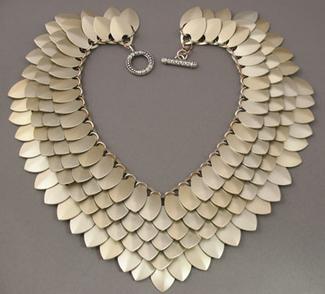Introduction to Scale Maille
This course is currently full. Spaces do occasionally open up so if you would like to be put on the wait list please call our office at 781-891-3854 or email [email protected]
Chain maille is a two thousand year old art form originally used to create garments worn for protection by warriors from Europe, the Middle East and the Orient. Modern approaches use these classical patterns of cold-connected jump rings for sculpture and jewelry. For these non-traditional applications, hundreds of new weaves or patterns have been invented.
In ancient times, outer material, usually metal or leather, was attached to chain maille for added protection. This workshop is an introduction to scale maille, with an aim toward producing ornamental jewelry or clothing. Students will come to thoroughly understand the weave and construct it with ease. Expect to go home with an aluminum scale maille collar, completed during class.
You can see more of Karen's work on her website www.karenkaron.com
Meet the instructor

Jewelry designer and author, Karen Karon, has been weaving maille for well over a decade. She teaches chain maille and scale maille classes and workshops at Metalwerx School for Jewelry and Metal Arts, at local venues, and also provides private chain maille/scale maille instruction. In addition, Karen is a certified PMC (Precious Metal Clay) artisan. Karen has written articles for Art Jewelry, Bead Style, Bead&Button and Step by Step Wire Jewelry magazines and is the author of Chain Maille Jewelry Workshop and Advanced Chain Maille Jewelry Workshop, both published by Interweave.
See Karen’s work on her website (karenkaron.com) or visit her on Facebook and Instagram.
Materials & Tools
There is a $25 materials kit for this workshop payable when signing up. The kit includes aluminum scales and jump rings to complete a collar, similar to the image here.
Please note that Metalwerx has pliers and optivisors on hand if students do not already have these tools.
- 2 Pairs of Pliers with Smooth Jaws - (2 chain nose, 2 flat nose, or one of each – use what you feel most comfortable with. Karen's preference is 2 flat nose pliers.)
- Optivisor or other form of magnification if necessary
- Tape (preferably blue painters tape because it is not so sticky, but any tape - scotch, masking, will do. We have rolls of tape available in the studio, but it may be preferable to bring your own.)

